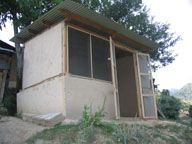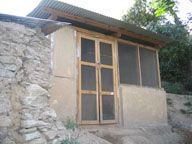Women's Empowerment in Earthquake Affected Area
Destiny Roti Kitchens - Corn for Health


Objectives
The Destiny Roti project for making tandoori corn nan or roti was conceived with the following objectives:
a. Further empowerment of women after great success was achieved through the Nokia-Karavan Craft Centres. Women to make extra rotis every day which would be marketed after proper packaging.
b. A methodology to involve the whole household i.e. men and young adults to get the corn ground in the water mills; 12-14 year olds to be involved in carrying the finished roti to the packaging centre.
c. Training and jobs for community in the packaging centre and process of marketing
d. A mechanism to teach women about hygiene and health
e. Promote the special corn flavour special to the area as health food
f. Revitalize damaged water mills because of their key role in giving the corn roti a special grainy flavour, as an attempt to promote indigenous techniques and promotion of alternative water energy to minimize reliance on electric power
g. Encourage the use of tandoor (earth ovens), allowing women to become earning members of their households
Outcome
In a nutshell the achievements are as follows:
a. Pride in tradition and heritage, Sense of Ownership
- Continuance of traditional ways of cooking roti and bringing pride in tradition.
- Promotion of health food special to the area
- A sense of ownership because of their own contribution
b. Sustainable solutions minimizing use of fossil fuel power
- Revitalizing and popularizing water operated grinding mills
- Preference of cooking roti in earth ovens rather than converting to electricity.
- Use of local materials in construction e.g. local stone, local mud, lime etc. minimizing reliance on transportation and cement products which cause greenhouse gases
c. Empowerment of women
- Making it possible for women to earn money within their homes
- Creating an elevated status for women in their family and community
d. Health and Hygiene
Emphasis on keeping kitchens clean for cleaner product; hand washing regimen, washing of utensils etc. to improve health of entire household, particularly children
e. Self-reliance and rising from apathy after the earthquake
By contributing 25% towards cost of kitchen, women have shown self reliance and are no longer apathetic towards their condition.
d. Adult Education
Adult Education has been initiated through the only woman who has graduated from class V. 6 women have joined the classes to read and write. The classes are being held in the Kodar Primary School which has been constructed under the programme.
Key Components
The following are the key components of the project:
a. Construction of 50 kitchens (with 25% contribution by the households) and 50% grant by I-Led. Thus, the remaining costs of the kitchens along with administrative and transportation costs are being borne by the Nokia-NSN-Karavan project. The contribution by households was considered crucial in developing a sense of ownership and subsequent maintenance of the facility.
b. Value addition to local farm produce.
c. Construction of a packaging centre for vacuum packing and sterilization of the product.
d. Use of local materials and local construction technique to popularize traditional techniques (being given up by communities in the wake of insistence on cement blocks/cement concrete and steel reinforcing bars), thus minimizing generation of green house gases
e. Establishment of a chain for marketing – Suzuki van to transport corn roti to cities in cold storage chambers.
Initial Difficulties
The programme had many initial difficulties. The fact that we had insisted on 25% contribution by households appeared a big stumbling block since the EQ-affected population have got used to receiving free goods. We started by selecting 10 women’s names in order to start 10 kitchens. As the work has been completed and the results are seen by the community, there has been a great demand to build more. Now we have names of all 50 beneficiaries. In fact now there is a rising demand from the surrounding villages of Aahl and Bagno to start a programme of kitchens there as well.
Since we are using wood in construction, difficulties were faced in getting wood at a reasonable price.
There were problems with the kind of steel plate that could be used around the tandoor (earth ovens) which could be cleaned. Initially we had planned to have standardized earth ovens and the plates could be moulded accordingly. However, the site conditions did not allow.
When tandoors were manufactured to a uniform size and supplied to the site, the women were not happy with the tandoors made by other potters, and wanted to have control over the kind of tandoor they wanted. The tandoors that arrived individually were all of different sizes. It was therefore decided to have each steel plate manufactured to fit around the tandoor opening.
Another problem that had not been anticipated was that the steel plate would become very hot and the households wanted that the plate should only be placed once the tandoor had been heated up and roti would be made. This would also help in keeping the steel sheet always clean. The sheets have been manufactured individually to fit the tandoor and are kept movable in order that they could be put away after the roti has been cooked.
Another issue that rose was related to storage of water which should always be clean. The universal choice is to use fiberglass storage tank. But these did not fit in our philosophy to minimize use of new materials which require use of energy for production. Accordingly, clay storage tanks are now being utilized, which are filled directly from the water supply. The storage of water is an important component since it inhibits carrying water in open containers from the source. In case, after testing it is found that the water through the water supply is not up to the standard required, water can be treated in the clay storage tank.
Sale of Tandoori Corn Nan
The soft launch of the programme is expected within the next couple of months. In the meantime preparations are being made to conduct hygiene workshops for participants.

